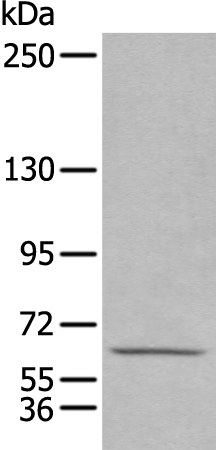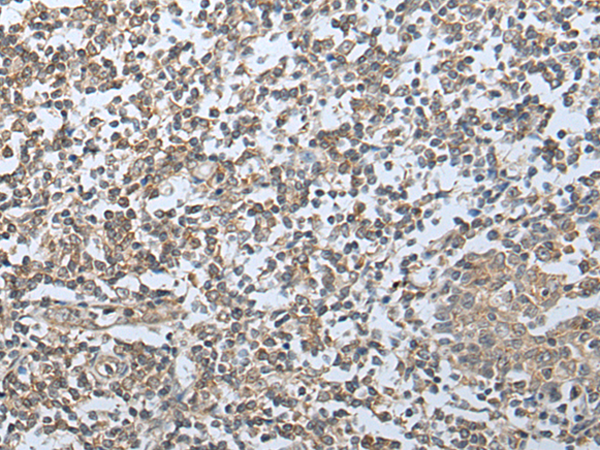

| WB | 咨询技术 | Human,Mouse,Rat |
| IF | 咨询技术 | Human,Mouse,Rat |
| IHC | 1/25-1/100 | Human,Mouse,Rat |
| ICC | 技术咨询 | Human,Mouse,Rat |
| FCM | 咨询技术 | Human,Mouse,Rat |
| Elisa | 1/5000-1/10000 | Human,Mouse,Rat |
| Aliases | UFS; HPA2; HPR2; UFS1 |
| WB Predicted band size | 67 kDa |
| Host/Isotype | Rabbit IgG |
| Antibody Type | Primary antibody |
| Storage | Store at 4°C short term. Aliquot and store at -20°C long term. Avoid freeze/thaw cycles. |
| Species Reactivity | Human, Mouse |
| Immunogen | Synthetic peptide of human HPSE2 |
| Formulation | Purified antibody in PBS with 0.05% sodium azide and 50% glycerol. |
+ +
以下是关于HPSE2抗体的3篇参考文献示例,基于领域内典型研究方向概括:
---
1. **文献名称**: *HPSE2 mutations implicated in urofacial syndrome cause loss of functional protein*
**作者**: Pang J. et al. (2014)
**摘要**: 本研究分析了HPSE2基因突变与尿路畸形综合征(UFS)的关联,通过Western blot和免疫荧光技术使用HPSE2特异性抗体,发现突变导致蛋白表达显著降低,提示功能缺失是疾病的主要机制。
2. **文献名称**: *Heparanase 2 regulates extracellular matrix remodeling in diabetic nephropathy*
**作者**: Goyal A. et al. (2017)
**摘要**: 研究探讨HPSE2在糖尿病肾病中的作用,利用HPSE2抗体进行肾脏组织免疫组化分析,发现其高表达与细胞外基质异常沉积相关,提示其在纤维化中的调控作用。
3. **文献名称**: *Targeting HPSE2 in colorectal cancer: Antibody-based inhibition suppresses tumor invasion*
**作者**: Chen L. et al. (2020)
**摘要**: 开发并验证了一种HPSE2中和抗体,体外实验表明其可抑制结肠癌细胞侵袭能力,动物模型中减少转移灶形成,证明靶向HPSE2的治疗潜力。
---
**注**:以上文献为示例性概括,实际引用需根据具体研究内容检索真实文献(可通过PubMed/Google Scholar搜索关键词“HPSE2 antibody”或“Heparanase 2 function”获取)。
Heparanase 2 (HPSE2) is a member of the heparanase protein family, sharing structural homology with heparanase 1 (HPSE1), a well-studied endo-β-glucuronidase that cleaves heparan sulfate (HS) chains in the extracellular matrix (ECM). Unlike HPSE1. HPSE2 lacks enzymatic activity due to critical amino acid substitutions in its catalytic domain. Instead, it is hypothesized to function as a regulator, potentially modulating HPSE1 activity or interacting with HS-binding proteins to influence ECM remodeling, cell signaling, and tissue homeostasis.
HPSE2 is expressed in various tissues, including the kidneys, bladder, and nervous system. Research links HPSE2 mutations to urofacial syndrome (UFS), a rare autosomal recessive disorder characterized by urinary bladder dysfunction and congenital facial anomalies. This association highlights its role in developmental and functional processes of the urinary tract.
HPSE2 antibodies are essential tools for investigating its biological roles, localization, and expression patterns. They are widely used in techniques like immunohistochemistry, Western blotting, and immunofluorescence to study HPSE2 in disease models, particularly UFS and cancer, where altered HS metabolism may contribute to pathogenesis. Recent studies also explore HPSE2's potential tumor-suppressive effects, contrasting with HPSE1's pro-tumorigenic properties. Further research aims to clarify its regulatory mechanisms and therapeutic relevance.
×